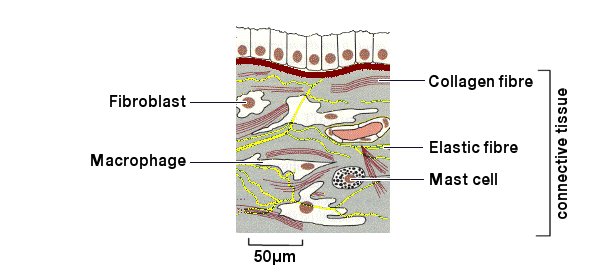Connective Tissue
Connective tissue is the strong tissues found in all animals that holds the body's various organs and tissues in place.
It is comprised of a glycoprotein ground substance or matrix in which a variety of different structures are embedded. It is the relative abundance of these embedded components which determines the precise nature of the connective tissue.

Fig.1 Connective Tissue.
Connective tissue is composed of:
Collagen Fibres
Also known as white fibres. They are flexible but very strong and inelastic protein fibres arranged parallel to each other in bundles.
Elastic Fibres
Also known as yellow fibres. They are individually branched fibres forming an extensive network.
Fibroblasts
Long flat cells that secrete the collagen and elastic fibres.
Mast Cells
Cells that secrete the matrix and an anti-coagulant.
Fat Cells
Cells that store fat.
Macrophages
Large amoeboid cells that ingest foreign particles and is important in defending the body against disease.
Classification of Connective Tissues
Areolar (loose)
Soft ground substance containing cells and a loose network of fibres, e.g. around and supporting the gut.
Adipose
Similar to areolar but fat-storing cells predominate, e.g. subcutaneous and around the kidney. It helps in the protection of organs.
Dense Fibrous
Fibres predominate.
- Regularly arranged fibres, e.g. tendons (mainly collagen fibres)
These join muscle to bone.
- Irregularly arranged fibres, e.g. ligaments (mainly elastic fibres)
These join bone to bone.
Reticular
A network of fine branching fibres supporting cells of viscera, e.g. Liver, Spleen.
Cartilage
Firm plastic matrix containing fibre
- Hyaline - translucent matrix with very fine collagen fibres, e.g. Trachea
- Fibrous - dense collagen fibres in a matrix, e.g. Inter-vertebral discs
- Elastic - elastic fibres in a matrix, e.g. Pinna, Epiglottis
Bone
Solid rigid matrix containing collagen fibres
- Spongy, e.g. ends of long bones
- Dense, e.g. shaft of long bones
